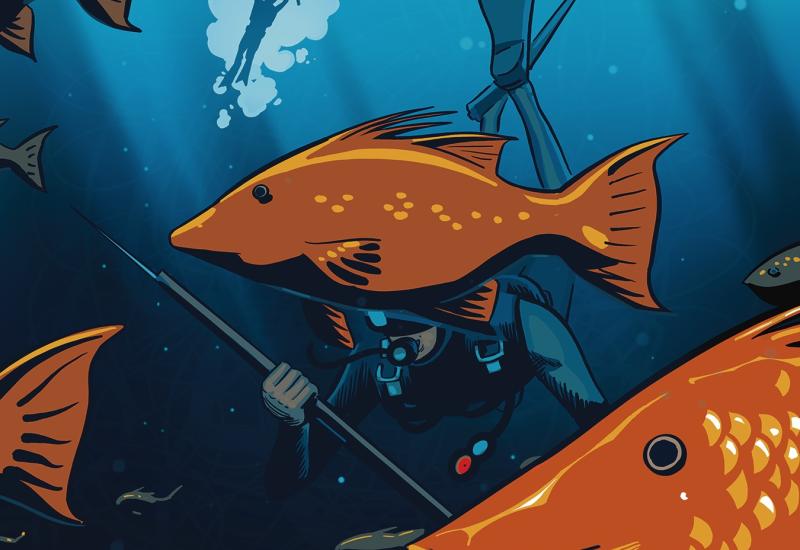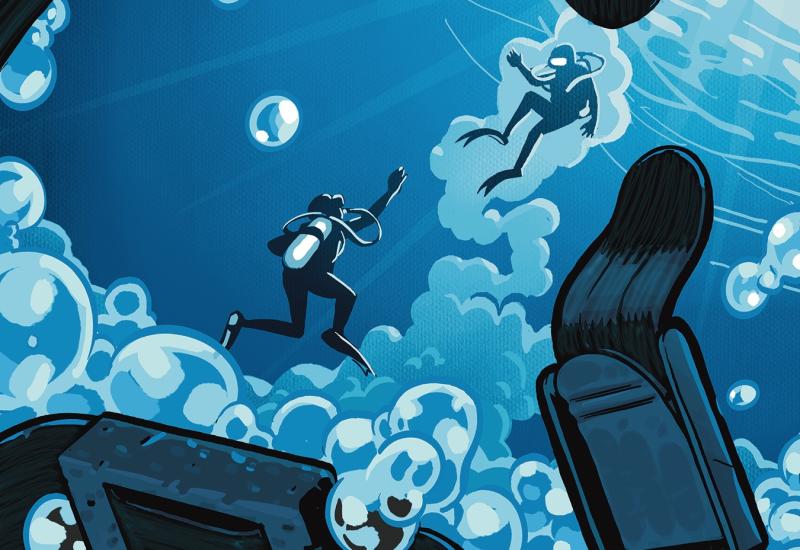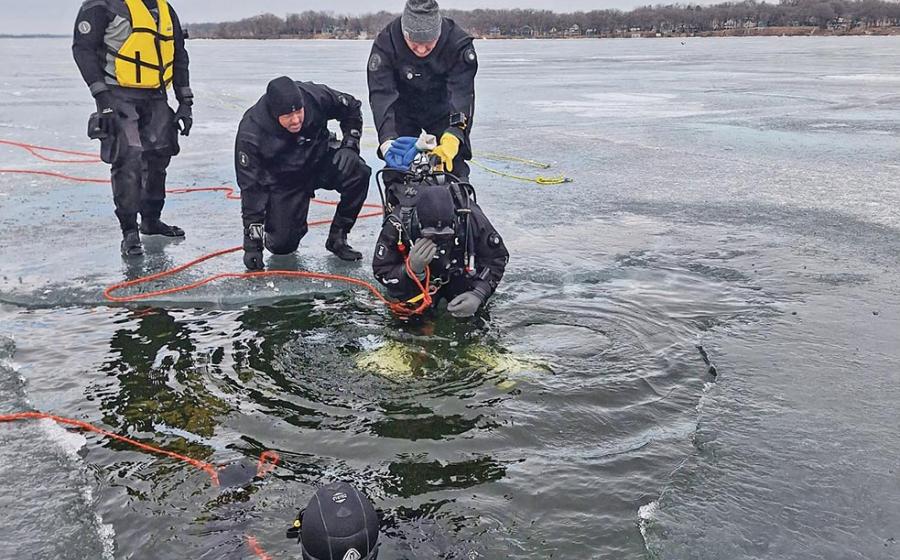A Fatal Miscalculation
 |
| Photography by Wes Skiles |
January 2004
By Michael Ange
Alone inside the cave, Bill finally located the guideline and his breathing relaxed to an almost normal pattern. He might make it out after all. Just a few yards farther along, he found the line arrows pointing toward the exit--1,400 feet to go. The tension eased from his body as he swam deliberately toward the exit. Then his regulator began to breathe hard. The equipment must be malfunctioning, he thought. What else could go wrong? Switching to his alternate, he found even more resistance. Terror struck when he saw his pressure gauge needle pegged at zero.
Meanwhile, on the surface, Jan put aside her book and anxiously searched the still surface of the spring for bubbles. Her husband Bill was nearly an hour overdue. She approached a nearby cave instructor to report her husband missing. The concern in the instructor's face as she spoke drove her to near panic and she became inconsolable as he used his cell phone to call for a recovery team.
The Diver
Bill was a healthy, experienced cave diver in his mid-40s with a background in engineering and mathematics. After completing dozens of cave dives, he decided to try a new challenge by going it alone. After several solo cave dives, Bill began to tinker with the rules used in cave training.
In discussions with cave instructors, Bill argued that the gas management protocol known as the rule of thirds was inefficient for an experienced solo cave diver like himself. The one-third reserve he'd been trained to keep was just wasted gas since there was no other diver who might need it. Based on his calculations, Bill decided to discard the tried-and-proven rule of thirds.
After a few uneventful dives using a rule of halves plus a 500-psi reserve, Bill was convinced that his technique was appropriate, even though several noted cave divers and instructors warned him against the practice.
The Dive
It was a brisk fall morning when Bill began his dive in a remote North Florida spring. After a final check of his equipment, he glanced back at his wife, leaving her contentedly reading a book. The water was clear and the current moderate when Bill secured his line to the rock outside the cave and began his initial penetration to the permanent line anchored 100 feet inside. Along the way, he switched from regulator to regulator to ensure proper function and checked all other equipment, satisfying himself that all was well with his gear.
He secured his reel to the cave's permanent guideline, marked the line with his identifying marker and continued his dive. When he reached his turn pressure of 500 psi over one-half of his tank, Bill noted with pride that he had penetrated farther into the system than on any previous dive. He took a few moments to revel in the beauty of the cave structure before turning for the exit. He swam several feet back down the passageway before he realized that the guideline was no longer in sight.
The Accident
Bill's training kicked in. He tied the line of his safety reel to the wall of the cave and began a systematic search for the guideline. Although he did eventually locate the line, the slow, deliberate search and the anxiety of losing the line probably accelerated his breathing, and he lacked sufficient air to complete the exit.
Analysis
The recovery team found Bill's body adjacent to the permanent line just a few hundred feet from the cave's exit. A forensic check of his equipment showed everything to be functioning properly, but his tanks were completely empty. Bill was found with some of his equipment removed, apparently discarded in the throes of panic as he realized that he would not survive the dive.
The rule of thirds is cave diving's tried-and-true method of gas management. It calls for divers to use one-third of their gas supply for entering and leaving a site, one-third for exploring and to keep one-third in reserve for emergencies. Like many divers, Bill falsely assumed that the one-third reserve is for sharing with a distressed buddy. In reality, its purpose is to allow time to deal with any emergency. Bill's primary mistake was failing to separate the certainties of mathematics from the harsh uncertainties of the real world.
Bill wasn't the only victim of his miscalculation, a thought that no doubt occurred to him in his final moments as he thought of his wife of 20 years waiting for him at the surface. Technical divers may be willing to assume great risk to push the bounds of underwater exploration, but their family members may not be so willing. Sobbing with grief as recovery divers removed Bill's body from the spring, Bill's wife was proof that he had miscalculated more than just his gas supply.
Lessons for Life
-
Follow the rules. The rules of diving are well-founded, validated and verified with tragic statistics. Don't become one.
-
Beware of Murphy's Law. Dive plans frequently go awry; therefore, every plan should include contingencies for foreseeable, but unexpected, challenges.
-
Consider nondivers. Perhaps an added step in dive planning would increase the safety of our sport among advanced divers: Consider all possible outcomes of your actions, including the consequences that may befall your loved ones in a worst-case scenario.
 | Photography by Wes Skiles|
| Photography by Wes Skiles|
January 2004
By Michael Ange
Alone inside the cave, Bill finally located the guideline and his breathing relaxed to an almost normal pattern. He might make it out after all. Just a few yards farther along, he found the line arrows pointing toward the exit--1,400 feet to go. The tension eased from his body as he swam deliberately toward the exit. Then his regulator began to breathe hard. The equipment must be malfunctioning, he thought. What else could go wrong? Switching to his alternate, he found even more resistance. Terror struck when he saw his pressure gauge needle pegged at zero.
Meanwhile, on the surface, Jan put aside her book and anxiously searched the still surface of the spring for bubbles. Her husband Bill was nearly an hour overdue. She approached a nearby cave instructor to report her husband missing. The concern in the instructor's face as she spoke drove her to near panic and she became inconsolable as he used his cell phone to call for a recovery team.
The Diver
Bill was a healthy, experienced cave diver in his mid-40s with a background in engineering and mathematics. After completing dozens of cave dives, he decided to try a new challenge by going it alone. After several solo cave dives, Bill began to tinker with the rules used in cave training.
In discussions with cave instructors, Bill argued that the gas management protocol known as the rule of thirds was inefficient for an experienced solo cave diver like himself. The one-third reserve he'd been trained to keep was just wasted gas since there was no other diver who might need it. Based on his calculations, Bill decided to discard the tried-and-proven rule of thirds.
After a few uneventful dives using a rule of halves plus a 500-psi reserve, Bill was convinced that his technique was appropriate, even though several noted cave divers and instructors warned him against the practice.
The Dive
It was a brisk fall morning when Bill began his dive in a remote North Florida spring. After a final check of his equipment, he glanced back at his wife, leaving her contentedly reading a book. The water was clear and the current moderate when Bill secured his line to the rock outside the cave and began his initial penetration to the permanent line anchored 100 feet inside. Along the way, he switched from regulator to regulator to ensure proper function and checked all other equipment, satisfying himself that all was well with his gear.
He secured his reel to the cave's permanent guideline, marked the line with his identifying marker and continued his dive. When he reached his turn pressure of 500 psi over one-half of his tank, Bill noted with pride that he had penetrated farther into the system than on any previous dive. He took a few moments to revel in the beauty of the cave structure before turning for the exit. He swam several feet back down the passageway before he realized that the guideline was no longer in sight.
The Accident
Bill's training kicked in. He tied the line of his safety reel to the wall of the cave and began a systematic search for the guideline. Although he did eventually locate the line, the slow, deliberate search and the anxiety of losing the line probably accelerated his breathing, and he lacked sufficient air to complete the exit.
Analysis
The recovery team found Bill's body adjacent to the permanent line just a few hundred feet from the cave's exit. A forensic check of his equipment showed everything to be functioning properly, but his tanks were completely empty. Bill was found with some of his equipment removed, apparently discarded in the throes of panic as he realized that he would not survive the dive.
The rule of thirds is cave diving's tried-and-true method of gas management. It calls for divers to use one-third of their gas supply for entering and leaving a site, one-third for exploring and to keep one-third in reserve for emergencies. Like many divers, Bill falsely assumed that the one-third reserve is for sharing with a distressed buddy. In reality, its purpose is to allow time to deal with any emergency. Bill's primary mistake was failing to separate the certainties of mathematics from the harsh uncertainties of the real world.
Bill wasn't the only victim of his miscalculation, a thought that no doubt occurred to him in his final moments as he thought of his wife of 20 years waiting for him at the surface. Technical divers may be willing to assume great risk to push the bounds of underwater exploration, but their family members may not be so willing. Sobbing with grief as recovery divers removed Bill's body from the spring, Bill's wife was proof that he had miscalculated more than just his gas supply.
Lessons for Life
Follow the rules. The rules of diving are well-founded, validated and verified with tragic statistics. Don't become one.
Beware of Murphy's Law. Dive plans frequently go awry; therefore, every plan should include contingencies for foreseeable, but unexpected, challenges.
Consider nondivers. Perhaps an added step in dive planning would increase the safety of our sport among advanced divers: Consider all possible outcomes of your actions, including the consequences that may befall your loved ones in a worst-case scenario.










